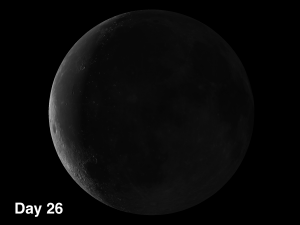 The week of April 1-7 takes us from lunar Day 26 to Day 2. This week the Moon is, for all practical purposes, not viewable. On Monday morning, it rises during bright morning twilight, and on Sunday evening, April 7, it’s only 15° over the horizon and a paltry 7% illuminated. The new moon is April 5th.
The week of April 1-7 takes us from lunar Day 26 to Day 2. This week the Moon is, for all practical purposes, not viewable. On Monday morning, it rises during bright morning twilight, and on Sunday evening, April 7, it’s only 15° over the horizon and a paltry 7% illuminated. The new moon is April 5th.
How the Seasons Affects the Moon
Many people do not understand why we have seasons and assume (not unreasonably) that it’s hotter in the summer because the Earth is closer to the Sun. But a few seconds of reflection should convince them that this is not the case. If the northern hemisphere is closer to the Sun in summer, then so is the southern hemisphere, but when it’s summer in the north, it’s winter in the south, so the logic falls apart.
As a matter of fact, the Earth is closer to the Sun in winter, but because of the tilt of the Earth’s axis, the sun’s rays hit the northern hemisphere at a more slanted angle in the winter, hence we receive less heat.
======================
It is highly recommended that you get a copy of Sky and Telescope’s Field Map of the Moon, the very finest Moon map available for use at the telescope. It is available for $10.95 at www.skyandtelescope.com and on Amazon. All features mentioned in this blog will be keyed to the grid on the Field Map and will look like this: Plato: [NW/D9]
Credits:
Courtesy of Gray Photography of Corpus Christi, Texas
Lunar photos: NASA / USGS / BMDO / LROC / ASU / DLR / LOLA / Moon Globe. Used by permission
- Rupes Cauchy: A Best Known Fault on the Moon - July 22, 2024
- Moon Crater Schickard – Crater Floor has Stripes - July 15, 2024
- Moon Craters Langrenus and Vandelinus - July 8, 2024